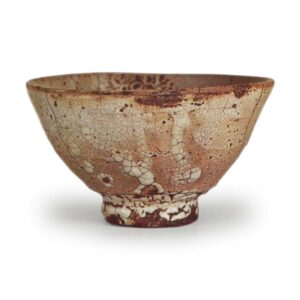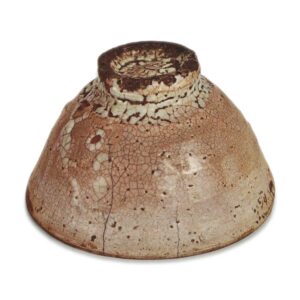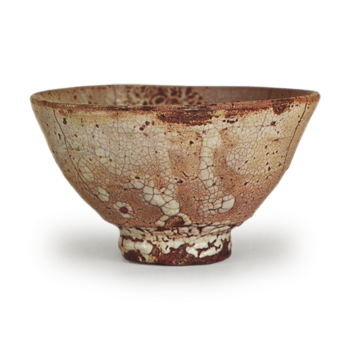

Height: 8.5-8.7cm
Diameter: 14.8-15.1cm
Foot diameter: 5.6-5.7cm
Height: 1.5cm
In the Taisho Meiki Kan, this tea bowl is referred to as an old well, but in terms of size and shape, it seems more like a large well. However, when compared to the typical famous old well tea bowls, it is slightly smaller, and this is probably why Takahashi Hoki-an referred to it as an old well. In this volume, it is included as a small well for convenience, but it can be said that the old priest, Nara, and Kanbayashi are somewhat different in character from what is called a small well. It seems appropriate to view it as a large well that cannot be obtained, as the tea masters of old used to say. On the other hand, Rokujizo, Bousui, Kosio, and Esumi can be said to be suitable for being called small wells.
The shape is that of a large well, but the diameter is a little small compared to the height, and the bulge of the body is a little thin, so it is a little lacking in dignity. Also, the thickness of the whole body can be said to be thin compared to the size. By the way, the highlight of this tea bowl is the overall glaze, and it can be said to be the most showy and scenic of the glazes of well tea bowls. The glaze is not particularly soft, but it is well-fired and glossy, and the white-tinged glaze flows from the rim to the foot of the bowl, clearly visible on the slightly reddish loquat-colored glaze.
The kaaragi (Japanese apricot skin) pattern that appears on the inside of the foot ring and around the rim is also clear and distinct, and there are few pieces that can match it in terms of the flashiness of the glaze. It is likely that Hōkōan compared this piece to the Roku Jizō because he recognized the commonality of such richly varied glazes. As mentioned above, it is a large bowl for a Koido, and it is similar in size to the old priest, but while the other is a dignified and stately work that is truly worthy of the old priest’s name, this one is lacking in a certain austere quality, but it is a bowl with a truly pleasant glaze, and I am not the only one who sees it as a pair with the other bowl.
There are no eyes in the interior, and although it is not clear, there are about eight on the foot ring. It is housed in a box made of zelkova with the two characters “Kanbayashi” written in gold powder on the lid, and it is thought that the name “Kanbayashi” is probably based on the legend that it was owned by Kanbayashi Chikuan, a tea master from Uji in the Azuchi-Momoyama period.
Chikuan served Hideyoshi and Ieyasu, and studied tea under Rikyu. During the Battle of Sekigahara in 1600, he and Mototada Torii holed up in Fushimi Castle. It is said that this tea bowl was formerly owned by Toyotomi Hideyoshi, or perhaps it was a gift from him to Chikuan.
It was later passed down to the Mitsui Hachiroemon family, but it is not clear when it entered the Mitsui family.



